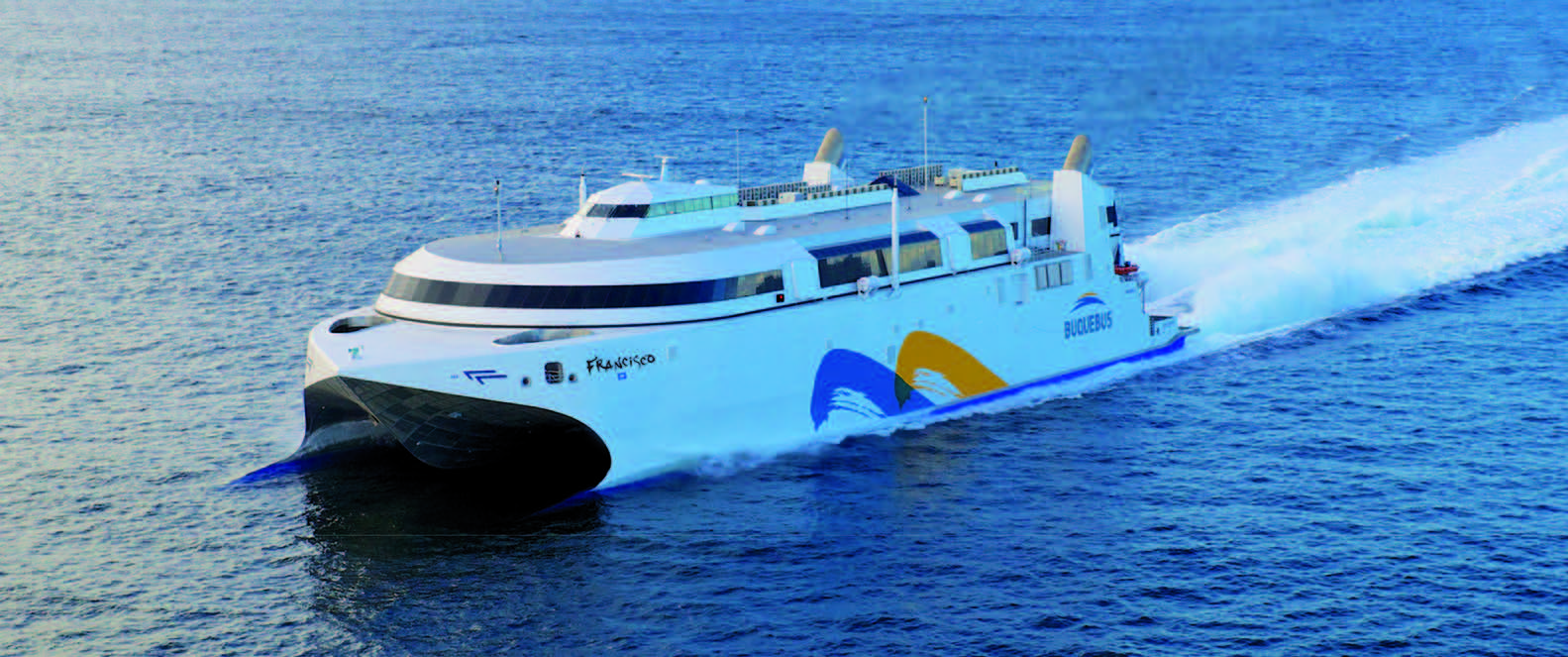

Catamaran fast ferry FRANCISCO
The world’s fastest ferry FRANCISCO was delivered in 2013 to the Argentinean owner Buquebus from the Australian shipbuilder Incat Tasmania Pty Ltd. The vessel was named in honour of the Buenos Aires born Pope of the Catholic Church. The vessel operates on the River Plate, between Buenos Aires, Argentina, and Montevideo, Uruguay.
The ship is capable of sailing at a speed of 51.8kt with a deadweight capacity of 450t. The propulsion system consists of two GE Energy LM2500 gas turbines, specially designed to burn both LNG or marine distillate and rated 22MW each, and a pair of Wärtsilä LJX 1720 SR axial waterjets. Wärtsilä has also supplied an advanced propulsion control system Lipstronic 7000.
The power plant uses marine distillate for start-up and during the ensuing minutes until the heat exchangers have produced enough gas from the LNG to allow changeover to LNG fuel. On arrival in port, the gas turbines revert to distillate for the vessel manoeuvring phase. The distillate will also serve as standby fuel.
Each prime mover and ancillary equipment is housed within a steel enclosure in each hull, and a 7:1 ratio ZF reduction gearbox is interposed on each driveline to a Wärtsilä LJX 1720SR axial waterjet. Configured for steering and reverse, the Wärtsilä design is notable for its comparatively small size, given the power input entailed. The proprietary Lipstronic 7000 system controls and indicates the steering angle, bucket position and impeller speed, and can be operated either by joystick or autopilot.
Two 200kW Caterpillar C9 gensets are installed to start the gas turbines, while another four 340kW Caterpillar C18 gensets are utilised for domestic use.
FRANCISCO has been fitted with two 43m3-capacity, super-insulated LNG storage tanks and associated cold boxes, with vaporisers, pumps, valves, bunker stations, control systems, safety detectors, a glycol circuit and a heat management system for the turbine exhaust gases. A cold box is effectively an airtight enclosure containing the wherewithal for fuel processing. Each hull of the catamaran has one LNG tank. Positioned amidships in a compartment immediately above the double bottom marine distillate bunker tanks, the gas tanks are of double-walled, stainless steel construction. They embody proprietary, multilayer composite vacuum insulation to maximise fuel capacity and maintain the LNG in its liquid state at a temperature of -163°C. Changeovers between LNG and distillate will be automatically controlled and will be performed as a ‘seamless’ operation.
The tanks provide for up to four hours of high speed operation, affording the requisite capacity to cover the round trip of 250 nautical miles on the River Plate service, so that bunkering need only be undertaken at one of the terminal ports. This is carried out at Buenos Aires from trucks drawing cryogenic tank trailers. The ship’s system has been designed to facilitate LNG refuelling in less than one hour, with simultaneous intake from two LNG trailers.
FRANCISCO accommodates 955 passengers and 150 cars on four tiers. Tier 1 is the vehicle deck providing an area of 4.5m in length and 2.3m in width for each car and an axle load of 2t each.
Tier 2 is subdivided into three areas. The first area is comprised of an economy-class aft lounge with seating areas and a bar, the second area provides a duty-free shop lobby featuring toilet facilities and the third area features a duty-free shop.
Tier 3 is subdivided into four areas. The first area comprises a tourist-class aft lounge with seating areas and a bar. The second area features a main foyer with a reception area, business lounges, and toilet facilities. The third area features a business-class mid lounge with seating areas, a bar, and toilet facilities. The fourth area is a first-class forward lounge featuring seating areas, a bar, a VIP lounge, and toilet facilities. The wheelhouse of the vessel is on Tier 4.
Length, oa: 99.00m, Breadth, mld: 26.94m, Depth, mld: 6.65m, Draught design: 3.09m, Deadweight design: 450dwt, Lightweight: 1063.2tonnes, Gross tonnage: 7109, Propulsion power: 2x22MW, Service speed at 85% MCR: 50 knots, Crew: 24.
